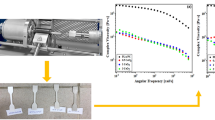Abstract
Acrylonitrile–Butadiene–Styrene (ABS), Polycarbonate (PC) and their alloys are widely used in automotive industry, computer and equipment housings. With increasing disposal of end-of-life electronic equipment, there is also an increased demand for recycling of these materials so that they do not pose environmental challenge as solid waste. One of the recycling approaches is mechanical recycling of these thermoplastics where recycled plastic is melt blended with virgin materials to obtain a high quality product. Besides obtaining desirable mechanical properties, such blends should also conform to fire safety standards. In this work, a series of blends were prepared using PC and ABS recovered from discarded computers and virgin materials using a twin-screw extruder. Their flammability properties were evaluated using burner flammability tests and Ohio State University (OSU) release rate tests. It was found that the extinguishing time, burning extent and weight loss appears to progressively decrease with the addition of both virgin or recycled PC to virgin or recycled ABS. It was also seen that the addition of the 70% of PC, virgin or recycled, to ABS virgin or recycled, appears to significantly decrease heat release and smoke evolution. The results of this study indicate that recycled polycarbonate can be used as an additive for virgin or recycled ABS, as a means of giving flame resistance to ABS in high-value applications. This result is significant when related to the result obtained by a separate study indicating that up to 25% of recycled material can be used without degradation of mechanical properties in the presence of 15% short glass fiber reinforcement.


Similar content being viewed by others
References
eCycling, U.S. Environmental Protection Agency (2005), http://www.epa.gov/epaoswer/hazwaste/recycle/ecycling/index.htm
Research and Demonstration Project for the Recycling of Plastics from Electronic Equipment-Final Report (2000) West Virginia University Research Corporation, Morgantown, WV, p 133
Liang R, Gupta RK (2001) Effect of residual impurities on the rheological and mechanical properties of engineering polymers separated from mixed plastics, The 59th ANTEC 2001, Society of Plastics Engineers, p 2753
Elmaghor F, Zhang L, Fan R, Li H (2004) Polymer 45:6719
Liu X, Bertilsson H (1999) J Appl Polym Sci 74:510
Liang R, Gupta RK (2000) Rheological and mechanical properties of recycled polycarbonate, ANTEC 2000, Society of Plastics Engineers, p 2903
Balart R, Lopez J, Garcia D, Salvador MD (2005) Eur Polym J 41:2150
Khan MMK, Liang RF, Gupta RK, Agarwal S (2005) Korea-Australia Rheol J 17:1
Al-Mulla, Gupta RK (2006) Recycling mixed plastics from end-of-life electronics, Proceedings Global Plastics Environmental Conference of Society of Plastics Engineers (on CD)
Dawson RB, Landry SD (2005) Recyclability of flame retardant HIPS, PC/ABS, and PPO/HIPS used in electrical and electronic equipment, Proceedings of the 2005 IEEE International Symposium on Electronics and the Environment, p 77
Acknowledgements
Funding for this work was provided by the U.S. Department of Energy. The authors wish to thank Professor Edwin Smith of The Ohio State University for his assistance and providing OSU test facilities for this work. M. M. K. Khan gratefully acknowledges provision of facilities and support during his sabbatical at WVU.
Author information
Authors and Affiliations
Corresponding author
Rights and permissions
About this article
Cite this article
Khan, M.M.K., Hilado, C.J., Agarwal, S. et al. Flammability Properties of Virgin and Recycled Polycarbonate (PC) and Acrylonitrile–Butadiene–Styrene (ABS) Recovered from End-of-Life Electronics. J Polym Environ 15, 188–194 (2007). https://doi.org/10.1007/s10924-007-0059-2
Published:
Issue Date:
DOI: https://doi.org/10.1007/s10924-007-0059-2




